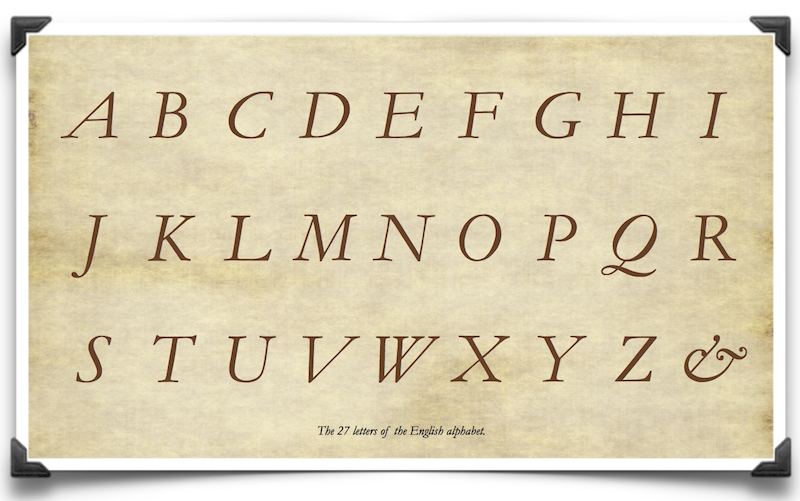There are 26 letters in the English alphabet. At one time there were 27.
It’s true.
Throughout the 19th century, there was an extra character after ‘Z’. It was this:

The symbol wasn’t new, it had been part of the Latin alphabet since the early 11th century. But its inclusion in the English alphabet started in the 1800s. Its name, or as it was referred to in the alphabet, was:
“and, per se, and”
When you recited the alphabet in the 19th century, here’s how you ended it:
…U, V, W, X, Y, Z, and, per se, and.

“And, per se, and”, in modern English, means “and the symbol, on its own, means ‘and’.”
Once the 20th century started rolling around, the language began to morph, as languages are wont to do. I’m not sure if people were drunk or lazy or what, but they began to slur together the words of this final “letter.”
“And-per-se-and” became “and-per-sand.”
Eventually, with the same lackadaisical linguistics that turns “sandwich” into “sam-wich”, the symbol previously known as “and-per-se-and” became the word we know today: “ampersand”
I tell you this because, first, it’s a really cool fact that may come in handy when you’re searching for small talk at your next linguistic club luau.
(Editors Note: you’re welcome)
Secondly, the story of the ampersand exemplifies one of the most important traits of successful leadership.
I love when that happens.

The Weird Ones
To uncover our alphabetical lesson on leadership, it’s important to put yourself in the proverbial shoes of the ampersand.
Yes, empathy is about putting yourself in somebody else’s shoes. And yes, empathy is a critical component of successful leadership.
You probably are proud of yourself for figuring out what this article is about. Too bad you’re wrong.
C’mon now. Do you really think I’d be so obvious?! Give me a little bit of credit, compadre. You know me better than that.
Ok, now where was I?
Oh yeah, the ampersand’s shoes.
Try to imagine how this confused little character felt when it became part of the alphabet.
The English alphabet had been around since the year 1100 AD (give or take). The letters of the alphabet got to know each other well. They bonded. They worked together every day. They were a unified team of 26 for about 700 years. Then, all of a sudden in the early 1800s, a new symbol was added to the group.
Unfortunately, this wasn’t a symbol that could automatically fit in with the others.
It was different.
Very different.
It looked… weird.
Whereas all the other letters were simple straight lines, smooth arcs, or a combination of the two, this new character was written in different ways, but always filled with complicated loops and curls and seemingly randomly placed lines.
It stood out like RuPaul at a Metallica concert.

Even worse, this new symbol had a weird name. Every other member of the alphabet was less a name and more of a sound, but this new fella… well, it didn’t even have a sound.
It was a word.
Can you believe it? A WORD… in the alphabet?!?!
What is happening to the neighborhood?!
In fact, the symbol needed to be described with four whole words (“and, per se, and”).
It took seven of the “normal” letters (a, n, d, p, e, r, s) to even describe the character. I’m sure those seven letters had better things to do with their time than fend for a weird new symbol who was trying to crash their close-knit community.
Understandably, the odd-looking new character was placed at the back of the list, separate from everyone else. Because that’s what we have historically done with the different ones – we shove them in the back of the bus. Literally and figuratively.

A Star Symbol Is Born
Much to the chagrin of the other letters, people began using the “and, per se, and” symbol more frequently.
The letters a, n, and d sat on the sidelines as the weird ‘&’ began to find its footing in the English language.
As more and more people started using the symbol, the symbol began evolving and feeling more confident.
Its very name, previously a confusing coupling of four words, started morphing into a one-named wonder, not far afield from the likes of Beyonce, Eminem and Cher.
Its unique look – the curve and flow of its appearance – allowed it to stand out from the blandness of the others.
Slowly and surely, the newly named Ampersand came into its own. It realized that it no longer needed to be associated with the tight clique known as the English alphabet. It had its own meaning, its own expertise and its own place in society.
It developed to such a level that there was no longer any place for the symbol in the alphabet. It hit the proverbial alphabetical ceiling.
So the Ampersand went solo. It separated from the rest of the letters.
You know how the story unfolded from here.
The Ampersand became an extremely powerful and universal symbol that spans languages and cultures. Its initially perceived oddities are now viewed as one of the most beautiful, flowing symbols in written language.
It is so universally revered, it is often printed larger than the letters in the English alphabet (who remain a tad ashamed and more than a bit jealous as they tell their “I knew her when she was just four words…” stories)
The Ampersand Lesson on Leadership
Your job as a leader is to understand the importance of the Ampersand’s story and apply the learnings to the way you treat others.
Not everyone looks the same.
Not everyone acts the same.
We don’t all talk or think the same.
Some of us think in straight lines and others in curlicues. We are all unique in who we are and the strengths we bring to any situation.
Inevitably there are people who, for whatever reason, are more different than others. Maybe it’s how they look.
How they talk.
How they think.
Maybe it’s what they wear.
Whatever it is, it doesn’t matter.
Different is good.
Different is important.
Different is where the magic of growth occurs.
Most new employees don’t fit into a company right away. Like the ampersand, it takes time to find their purpose in the group. But everybody has something special about them that helps them stand out from the crowd.
It’s the job of successful leaders to discover that unique talent in everyone and work to nurture it and help it to flourish.
(Disclaimer: I’m an executive coach that helps leaders find and flourish the special qualities within themselves. Oh have I got stories for you.)

When the Ampersand Leaves
If you do everything extremely well as a leader, your best people will probably leave you. Like the ampersand, they will go off to bigger and better things.
Just so we’re clear, that’s good.
Your primary job as a leader is to help your subordinates be great leaders.
If you do your job well, there are only two options for the best people:
- They either rise up in your company, or,
- They get a better job somewhere else.
That is success.
Your employees need your leadership to help them flourish, just like the ampersand needed the English alphabet to find itself. In fact, without its place in the alphabet, it wouldn’t even have its name.
But once it found its footing and forged its growth, there was nowhere else for it to go in the alphabet. It had to leave the alphabet and strike out on its own in order to gain the international acceptance it now receives.
After all, Beyonce didn’t become a megastar until she left Destiny’s Child, Eminem had to split from D12, and Cher…. well, Sonny Bono was better off as the Mayor of Palm Springs.
The 5 Leadership Lessons From The Ampersand
This is all pretty critical for you to understand as you rise in your career. So let me do you a solid and give you the five leadership lessons you can get from the ampersand and its rise to glory.
1. Empower
Trust your team members. Empower them to make decisions. Don’t leave them flailing in the background like how the ampersand started.
2. Mentor
Actively mentor your subordinates. Share your experiences, mistakes, and learnings to help them find the special ampersand in themselves.
3. Collaborate
Encourage people to work together and learn from each other. Collective growth leads to innovation. It allows people to morph from an “and, per se, and” to an Ampersand.
4. Communicate
Maintain transparency in all you do. When your subordinates feel they can approach you with ideas, concerns, or feedback, it builds trust and encourages the growth of the ampersand within.
5. Recognize Potential
Recognize and nurture the strengths of each of your subordinates. Everybody has a special ampersand inside them.
Remember, by helping your subordinates flourish into their own special ampersand, you are building a powerful legacy for you and for them.
—
I hope you enjoyed this story about the alphabet cause, hot diggity, I enjoyed writing it.
Oh, &…
A Somewhat Relevant Quote
“Somewhere along the way we must learn that there is nothing greater than to do something for others.“
Martin Luther King, Jr., preacher, dreamer, empowerer of others
Random News
Hidden Meaning – Things in logos you didn’t know were there
Garlic Needed – Another vampire grave has been discovered
Pass Complete – When a scholarship is more than a scholarship
Aged – Visit the oldest bar in every state
